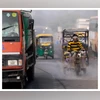It’s easy to pin the blame on stubble burning for Delhi’s dark skies and foul-smelling air while ignoring the role of transport in the capital’s emissions. The average contribution from stubble burning to PM2.5 levels in Delhi was below 10 per cent in October, compared to transport accounting for a fifth of the asthma-inducing particulate matter prevalent year-round, according to CREA, a Finnish think tank.
Emissions from transport are expected to multiply, blacking out the sun from Delhi to Chennai, as cars and trucks proliferate, along with the fuels they burn under current policies. This is the key finding of a yet-to-be-published study by TERI, India’s leading think tank and advisor to governments, on India’s rapidly growing vehicle population. The study’s forecasts on vehicle and fuel demand, stretching up to 2070, will influence India’s new Nationally Determined Contributions (NDC) document—emissions reduction plans to clean up the air—to be submitted to the UN Climate Change by next February.
The transport sector has been the second-highest emitter of CO2, after the electricity and heat production sector, contributing almost 23 per cent of global CO2 emissions. The sector accounts for 5 per cent of GVA in India, but its share of CO2 emissions from energy use is 12 per cent. According to the study, the unchecked proliferation of vehicles could push transport’s share of India’s overall emissions. Other studies expect transport emissions to jump to over 20 per cent by 2030-31, making it the country’s second-largest source of pollution.
TERI undertook the project to forecast India’s transport demand until 2070-71, when the country aims to achieve net-zero emissions. The study assesses the sector’s baseline emission trajectory and explores strategies to mitigate emissions through technology-driven measures. These include improving fuel economy, promoting alternative fuel technologies, incorporating biofuel blends, and increasing the share of freight carried by railways, said Sharif Qamar, associate director at TERI, to Business Standard.
Broadly, the findings reveal a surge in emission-intensive road transport over the next five decades for both passenger and freight movement, often at the expense of public transportation such as trains and buses. The vehicle population is expected to rise significantly, driven by a fourfold increase in passenger demand and a 12-fold increase in freight demand between 2019–20 and 2070–71.
A notable trend identified by the study is a shift towards four-wheelers, which have a higher greenhouse gas (GHG) footprint per kilometre, at the expense of buses and two-wheelers, which have a lower carbon footprint. By 2070–71, the share of four-wheelers is projected to exceed the combined modal share of buses and two-wheelers (31 per cent). In freight, medium and heavy goods vehicles (MHGVs) are expected to increase their share by 20 percentage points to 89 per cent over the same period.
The transport sector currently accounts for almost 80 per cent of high-speed diesel (HSD) and 99 per cent of petrol consumption in India, highlighting the need to mitigate road transport emissions. Goods vehicles are expected to grow sixfold to 69 million by 2070–71, while road freight demand is expected to grow 15 times to 29.76 billion tonne-kilometres (BTKM). Passenger vehicle numbers could rise nearly fivefold to 897 million, with travel distances reaching 29,251 billion passenger-kilometres (BPKM) from just 6,098 BPKM during the same period.
The study emphasises the immense potential of railways in decarbonising transport, especially in freight. However, despite the railways’ plans to increase its freight share to 35 per cent by 2030-31 and 45 per cent by 2040-41, TERI projects the share of railways in freight transport to decline from 26 per cent to just 8 per cent by 2070–71 without aggressive policy interventions.
The study also notes a shift from petroleum products to natural gas as a transportation fuel. Petrol demand is expected to peak at 94 million tonnes of oil equivalent (Mtoe) by 2044-45, while diesel demand is expected to peak at 234 Mtoe by 2056-57. Demand for compressed natural gas (CNG) and liquefied natural gas (LNG) is expected to grow significantly. CNG demand could triple to 10 million tonnes by 2030-31 and increase nearly 15-fold by 2050-51. LNG use in transportation, projected at just 0.4 million tonnes by 2030-31, could rise to 7.4 million tonnes within two decades, around a quarter of today’s total LNG imports.
The transition to cleaner fuels faces challenges, as fossil fuels are expected to account for over 60 per cent of transport fuel demand by 2070–71. Medium and heavy trucks, which primarily run on diesel, emit the most pollutants and are the hardest to decarbonise due to economic and technological barriers, industry experts noted.
“While electric vehicle technology has started gaining traction in India, its penetration in the freight segment remains very low,” said Rahul Chakraborty, an author of the study. “Additionally, hydrogen as a transportation fuel is still in its early stages of development.”
India's transport sector boom to push fuel use, emissions higher: Study
The transport sector is the second-highest emitter of carbon dioxide (CO2) globally, after the electricity and heat production sector
)
Photo: Bloomberg
Listen to This Article
Topics : transport sector COP29 Carbon emissions
Don't miss the most important news and views of the day. Get them on our Telegram channel
First Published: Nov 25 2024 | 8:45 PM IST
